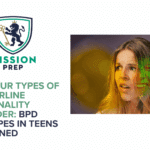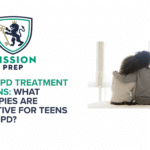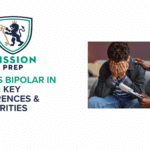Causes of BPD in Teens: How Trauma & Other Risk Factors Can Lead to Borderline Personality Disorder

Borderline Personality Disorder (BPD) doesn’t just show up out of the blue. For many teens, it develops over time and is often shaped by early emotional experiences, ongoing stress, and how their brain responds to these situations. For instance, research shows that a large number of teens with BPD have been through some form of trauma, like emotional neglect.¹
When a young person’s nervous system is constantly on high alert, it becomes harder to manage emotions, form stable relationships, or feel secure in who they are. Plus, these difficulties can manifest as mood swings, often leading to BPD being misdiagnosed as bipolar disorder.
Understanding the causes of BPD in teens means looking at the full picture, including family history, childhood relationships, emotional sensitivity, and even genetics. For example, early attachment trauma, identity struggles, and overwhelming emotions can all play a role in the causes of BPD in teens.
If you’re worried about BPD in a teen, a mental health professional can guide you down the right path. This guide can also help by exploring:
- What borderline personality disorder is
- The link between trauma and BPD in teens
- The genetic risk for BPD
- Types of trauma-informed youth care for teens
- How Mission Prep can help with complex trauma in adolescence

What Is Borderline Personality Disorder?
Borderline personality disorder (BPD) affects how a teen manages emotions, builds relationships, and sees themselves. It’s not just about moodiness or typical teenage ups and downs. BPD can create deep emotional pain and confusion, both for the teen and the people who care about them.
Many parents first notice something feels “off” around middle school or early high school. For instance, teens might suddenly struggle with big emotions, feel abandoned over small things, or swing between seeking closeness with someone and pushing them away.
These shifts in mood and behaviors aren’t always a sign of shifting hormones and development. They often point to early BPD development stages, where emotional patterns and personality traits start to take shape.
Here’s what the early signs of borderline personality disorder in teens can look like:²
- Emotional outbursts that seem exaggerated for the situation
- Fears of being left out or abandoned
- Fear of rejection
- Unexpected friendship changes and changes in interests
- Risky decision-making and self-harm
- Feeling empty or unsure of who they are
These BPD traits may begin as adolescent emotional trauma builds up or when a teen has lived through teen neglect, unpredictability, or early attachment trauma. Over time, if left untreated, these patterns can harden into deeper emotional struggles, making relationships, school, and self-worth more difficult to manage.
Understanding what BPD is helps us respond with compassion, not confusion. When teens are met with trauma-informed youth care, they can begin to rebuild trust in themselves and others.
BPD Development Stages
Researchers have identified a developmental pathway for BPD that often unfolds in three broad stages, including:³
Early vulnerability (childhood)
BPD risk factors can include going through some form of childhood trauma. As a result, a child may struggle with emotion regulation or show signs of anxiety, sensitivity, or distrust in close relationships.
Emerging traits (early adolescence)
Emotional instability becomes more visible. Teens may show identity struggles, low self-worth, or patterns of idealizing and devaluing others. There might also be signs of adolescent emotional trauma, impulsivity, or mood reactivity
Clinical features (mid-to-late adolescence)
BPD patterns often become more consistent and impairing at this point. A teen might meet criteria for a personality disorder risk diagnosis, especially when emotional dysregulation, unstable relationships, and self-harming behaviors persist.
These stages don’t mean BPD is inevitable. But when youth risk factors and environmental triggers combine, especially trauma, unstable caregiving, or invalidating environments, they can shape how a teen learns to cope with stress, feelings, and relationships.
Understanding these stages gives parents and clinicians a clearer window into how personality disorders develop. It also guides early, trauma-informed youth care, which can change the course of a teen’s life.
Trauma and BPD Link in Teens
Not all teens with BPD experience trauma, but research shows us that there’s a very strong link.⁴ This may be especially the case for trauma that happens repeatedly.
For instance, emotional abuse, ongoing criticism, or feeling constantly misunderstood can deeply impact how a young person sees themselves and others. Plus, when trauma is paired with unstable attachment, like unpredictable or unavailable caregiving, it can make it harder for a teen to trust, feel secure, or regulate their emotions.⁵
Some of the most common forms of trauma linked to BPD in teens include:
- Emotional abuse or repeated invalidation
- Neglect (both physical and emotional)
- Early attachment trauma, especially in the first years of life
- Unpredictable caregiving environments
- Witnessing violence or experiencing abandonment
Experiences such as those listed don’t just affect mood. They can shape the nervous system and how the brain processes stress and relationships. As a result, they can lead to personality disorder risk in youth, especially when trauma goes untreated or unnoticed.
It’s important to remember that complex trauma in adolescence doesn’t guarantee a teen will develop BPD. But it increases the risk, especially when combined with genetic factors or other environmental triggers.
Trauma-informed care is important because teens showing signs of emotional dysregulation deserve support that takes the focus off blame and redirects it to healing.
What’s Happening in the Brain During Teen BPD?
When a teen goes through early emotional trauma, their brain starts rewiring to survive, not connect. Over time, this rewiring can make it harder to regulate emotions, trust others, or feel safe in close relationships.
For example, the amygdala (the brain’s alarm system) can become overactive, constantly scanning for threats. At the same time, areas that help with calming down, like the prefrontal cortex, may struggle to keep up. This imbalance can lead to intense emotional swings, impulsivity, and patterns that mirror the core traits of borderline personality disorder.
In other words, trauma doesn’t just shape behavior – it can literally change how the brain processes stress, emotion, and connection. But with the right support, it can also heal.
The Genetic Risk for BPD
While trauma and environment play big roles in the development of BPD, research also shows there’s a genetic risk for BPD.
Studies show that BPD tends to run in families, with heritability being at around 46%.⁶ Therefore, if a parent or sibling has the disorder, the chances of a teen developing BPD traits increase. Yet, BPD isn’t inherited like a person’s height or eye color is. Instead, certain traits like emotional sensitivity, impulsivity, and mood dysregulation can be influenced by genetics.
One way to think about the genetic risk for BPD is that genetics can load the gun, but the environment pulls the trigger. In other words, a teen may be born with a more reactive nervous system or an increased sensitivity to emotional stress. But when this is paired with childhood adversity, the likelihood of developing adolescent borderline traits over time increases.
Some of the inherited traits that may increase BPD risk include:
- Acting impulsively
- Being emotionally reactive
- Becoming easily distressed
- Anxiety or depression
But genetics isn’t destiny. Even when there’s a strong family history, protective factors like supportive relationships, access to therapy, and trauma-informed care can make a meaningful difference in a teen’s outcomes. This is why early intervention is so critical, especially when youth personality vs mood disorder concerns arise.
Types of Trauma-Informed Youth Care for Teens
When a teen lives with the effects of early trauma, the way we offer support matters just as much as the support itself. This belief is the foundation of trauma-informed youth care, as it focuses on understanding that every behavior happens in the context of what someone has lived through.
Additionally, teens facing complex trauma in adolescence don’t just struggle with symptoms. They’re also often riddled with shame, being “too much,” and fears of rejection. Trauma-informed care recognizes these wounds and focuses on safety, trust, and connection.
At Mission Prep, we use trauma-informed therapies to treat BPD, including the following options:
- Attachment-focused therapy: Research shows that attachment is central to BPD.⁷ Therefore, this form of therapy can help teens understand how early attachment trauma can shape current emotions, relationships, and self-image.
- Dialectical behavior therapy (DBT): DBT supports emotion regulation and teaches practical tools for managing distress, which can be especially helpful for teens at risk of developing BPD.⁸
- Somatic-based practices: These reconnect teens with their bodies and can help discharge the physical residue of trauma without needing to “talk it all out.”⁹
Trauma-informed youth care also means we don’t rush to label or diagnose. It’s important to take time to understand lived experiences, explore environmental triggers for BPD, and offer consistent support.
Teens are more than their diagnoses or behaviors. With the right approach, even those dealing with childhood trauma and personality disorders can move toward stability and connection.

Reach Out to Mission Prep for Help with Complex Trauma in Adolescence
At Mission Prep, we understand that what can look like “acting out” or exaggeration is often a sign of unresolved trauma or attachment issues. Our team of qualified and experienced clinicians uses trauma-informed, developmentally sensitive approaches to treating teens in need.
We look beyond “labelling” and take time to understand a teen’s history, current challenges, and environment – focusing on long-term healing and not just symptom relief.
If your family needs support navigating complex trauma in adolescence, or you’re unsure what’s causing your teen’s distress, we’re here to help. Reach out to Mission Prep to learn more about our therapeutic programs and trauma-informed youth care.
References
- Bozzatello, P., Rocca, P., Baldassarri, L., Bosia, M., & Bellino, S. (2021). The role of trauma in early onset borderline personality disorder: A biopsychosocial perspective. Frontiers in Psychiatry, 12, 721361. https://pmc.ncbi.nlm.nih.gov/articles/PMC8495240/
- Lazarus, S. A., Choukas-Bradley, S., Beeney, J. E., Byrd, A. L., Vine, V., & Stepp, S. D. (2019). Too much too soon?: Borderline personality disorder symptoms and romantic relationships in adolescent girls. Journal of Abnormal Child Psychology, 47(12), 1995–2005. https://pmc.ncbi.nlm.nih.gov/articles/PMC7045362/
- Stepp, S. D. (2012). Development of borderline personality disorder in adolescence and young adulthood: Introduction to the special section. Journal of Abnormal Child Psychology, 40(1), 1–5. https://pmc.ncbi.nlm.nih.gov/articles/PMC3865353/
- Malafanti, A., Yotsidi, V., Sideridis, G., Giannouli, E., Galanaki, E. P., & Malogiannis, I. (2024). The impact of childhood trauma on borderline personality organization in a community sample of Greek emerging adults. Acta Psychologica, 244, 104181. https://www.sciencedirect.com/science/article/pii/S0001691824000581
- Dagan, O., Groh, A. M., Madigan, S., & Bernard, K. (2021). A lifespan development theory of insecure attachment and internalizing symptoms: Integrating meta-analytic evidence via a testable evolutionary mis/match hypothesis. Brain Sciences, 11(9), 1226. https://pmc.ncbi.nlm.nih.gov/articles/PMC8469853/
- Skoglund, C., Tiger, A., Rück, C., Petrovic, P., Asherson, P., Hellner, C., Mataix-Cols, D., & Kuja-Halkola, R. (2021). Familial risk and heritability of diagnosed borderline personality disorder: A register study of the Swedish population. Molecular Psychiatry, 26(3), 999–1008. https://pmc.ncbi.nlm.nih.gov/articles/PMC7910208/#:~:text=In%20conclusion%2C%20BPD%20aggregates%20in,increase%20the%20risk%20of%20BPD
- Agrawal, H. R., Gunderson, J., Holmes, B. M., & Lyons-Ruth, K. (2004). Attachment studies with borderline patients: A review. Harvard Review of Psychiatry, 12(2), 94–104. https://pmc.ncbi.nlm.nih.gov/articles/PMC1857277/
- May, J. M., Richardi, T. M., & Barth, K. S. (2016). Dialectical behavior therapy as treatment for borderline personality disorder. The Mental Health Clinician, 6(2), 62–67. https://pmc.ncbi.nlm.nih.gov/articles/PMC6007584/#:~:text=Dialectical%20behavior%20therapy%20(DBT)%20is,emotion%20regulation%2C%20and%20distress%20tolerance
- Nelson, K. J., Zagoloff, A., Quinn, S., Swanson, H. E., Garber, C., & Schulz, S. C. (2014). Borderline personality disorder: Treatment approaches and perspectives. Clinical Practice (London, England), 11(3), 341–349. https://www.openaccessjournals.com/articles/borderline-personality-disorder-treatment-approaches-and-perspectives.pdf


















